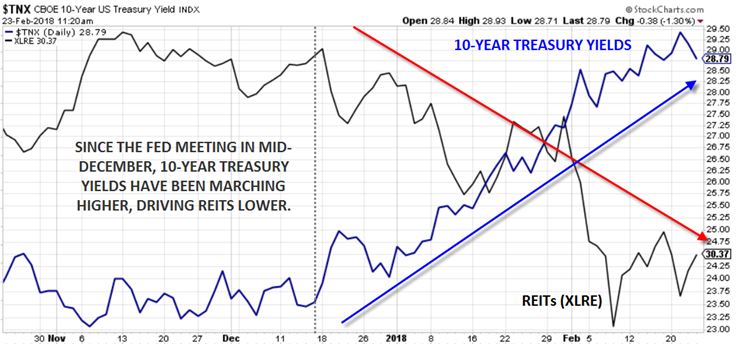Since the first iteration of the Federal Reserve’s Quantitative Easing (QE) program were announced nearly a decade ago, traders have been calling for an end to the 35-year bull market in US bonds (i.e. falling yields).
Is 2018 finally the year that the bond bear market takes hold? It’s certainly tempting to think so.
After all, the yield on the benchmark 10-year treasury has more than doubled off the mid-2016 low at 1.36%, rising by more than 30bps in the first two months of this year alone. This move has been backed up both by tighter monetary policy, with the Fed gradually reducing its balance sheet and on track to raise interest rates as much as four times this year, as well as more stimulative fiscal policy, highlighted by a massive US tax cut and potential infrastructure bill on the horizon.
As the chart below shows, the rally in yields (blue line) kicked off in earnest in mid-December, leading directly to a big selloff in Real Estate Investment Trusts (REITs, here visualized by the XLRE ETF):

Source: Faraday Research, Stockcharts.com
The explanation for the relationship between interest rates and REITs is twofold. First, rising yields on government bonds makes high-yielding (but less safe) REITs less attractive to investors. Second, the increase in yields directly increases interest expenses for REITs, which tend to borrow heavily to finance real estate purchases, making it more difficult for REIT managers to raise payouts in the future. In other words, a rise in Treasury yields simultaneously decreases the prospect of future payout increases for REITs and makes those payments less attractive on a relative basis. Put numerically, the 50-day correlation between the 10-year treasury yield and the REIT ETF is -0.90, a very strong inverse relationship.
Whether the Treasury market continues to selloff remains to be seen; after all, the latest Commitment of Trader report showed that large speculators were overwhelming short treasury bonds, so a counter-trend “shakeout” cannot be ruled out. In any event, the rapid, one-directional move higher in yields is likely to become more of a two-way trade in the weeks to come. This outcome, if seen, could relieve some of the pressure on the beleaguered REIT sector.







